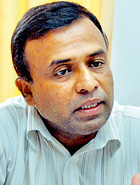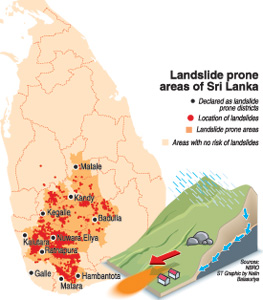The relocation of houses in the landslide prone areas of the country has reportedly not been completed despite a circular sent by the Disaster Management Ministry last February.
The Ministry issued a circular stating that no new constructions can be made in areas identified to be landslide-prone without the authorisation of the National Building Research Organisation (NBRO) and if it takes place with local government authorisation without approval from NBRO, the respective authorities will be held responsible for any resultant consequences.
 |
R.M.S Bandara: Head of landslide studies and services division
Pic by Sanka Vidanagama |
In addition, the existing houses in landslide prone areas should be relocated by the local bodies, according to the Ministry. “We don’t have figures of the number of houses that need to be relocated now,” said Disaster Management Centre (DMC) Official Pradeep Kodippili. The local bodies have the authority to evacuate or relocate the families, he said.
In some districts, State lands have been identified, according to Mr. Kodippili. “It can’t be done fast. They (district authorities) are in the process of identifying the areas,” he said.In Nuwara Eliya, there are 2,103 houses in landslide-prone areas, among which 80 are in high hazard zones, according to the disaster management office. In Badulla, 60 of 250 families in landslide-prone areas are in high hazard zones.
Lands owned by the Railway Department and private estates have been identified for relocation in Badulla - 10 perches each for the 60 families - while Nuwara Eliya is in the process of identifying more lands from private owners, apart from the State-owned areas, to relocate the displaced families.
Nuwara Eliya District Secretary D.P.G. Kumarasiri said the families can be relocated before the inter-monsoon period begins in October-November. There are early warning systems in Nuwara Eliya and Ratnapura and the communities have been provided with rain gauges, said Mr. Kodippili.
“We are making the people aware of the landslide-prone areas. Even though many places have been identified, people don’t want to relocate,” he explained, citing that the same happened in tsunami-affected areas.
Through its landslide hazard zoning mapping project, the NBRO has identified 10 areas - Badulla, Nuwara Eliya, Kegalle, Ratnapura, Kandy, Matale, Kalutara, Galle, Matara and Hambantota.
The organisation has classified land into four zones – high, medium and low hazards, and safe zones. While constructions shouldn’t be done in high hazard zones, people can build houses following guidelines in medium and low hazard zones. “About 40 per cent are not getting approval. In Sri Lanka, any permanent construction needs an approval. But, in rural areas, there are encroachments as well.
We are conducting awareness programmes to tell people about its importance,” said NBRO Director General Asiri Karunawardena, explaining that their goal was to reduce damage due to landslides.
Landslides can be caused due to natural as well as man-made changes, said R.M.S Bandara, head of landslide studies and services division. While rainfall variations, geological and hydrological settings are part of the natural reasons, changes to natural slope due to improper cutting is the main man-made change.
“Colombo and Gampaha are also becoming landslide prone areas due to improper land use. There were several landslides in Kandy during early 2011, mostly due to bad land use practices. Gradually man-made landslides are increasing more than the natural factors. It could be called cutting failures.”
NBRO examines the areas to approve construction activities, after getting applications from the local authorities. Factors such as the soil type, geological aspects and the construction methodology are reviewed and clearance certificates are issued later.
“We have three categories of giving clearance - recommendation, recommendation with guidelines or rejection,” he said.
Once the land is approved, the district secretary is notified, who in turn will authorise the constructions after informing the respective village authorities.
“We can’t neglect the high hazard zones because the country is small,” said Mr. Bandara elaborating that the institute is trying to find methods to re-use high hazard zones.
The approval is free of cost at present. However, the NBRO will charge ‘a nominal fee’ from September. “In the suggested fee structure, a fee of Rs. 100 will be charged from low income families and Samurdhi beneficiaries,” said the Director General. |



